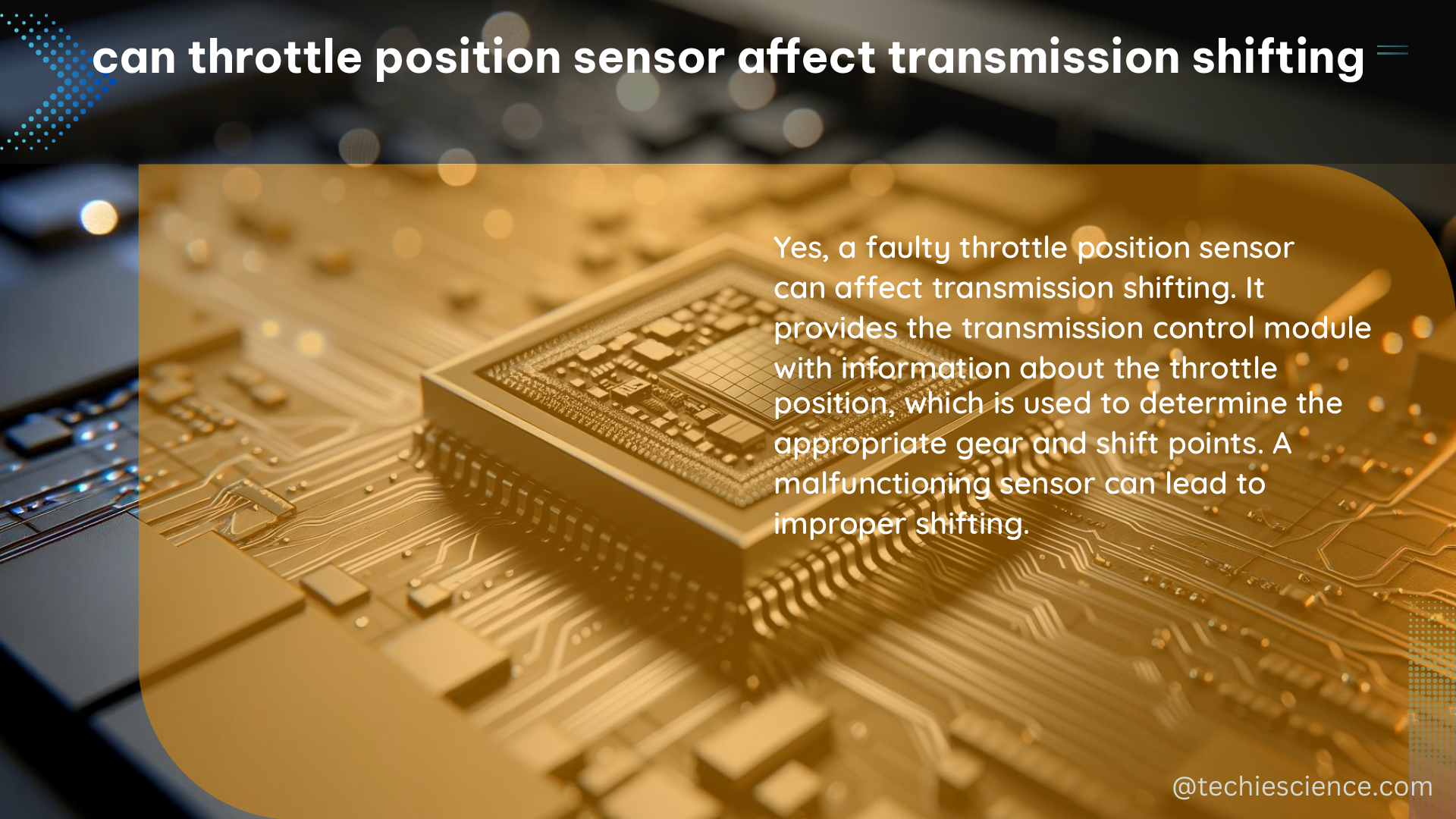The throttle position sensor (TPS) is a crucial component in modern vehicles, measuring the position of the throttle blade. A faulty TPS can cause several noticeable symptoms, including issues with engine and transmission performance. In an electronic throttle control (ETC) system, the TPS works in conjunction with the sensors in the transmission to control throttle operation. If one of the sensors fails, the control module may put the vehicle in “limp mode” or “reduced power mode” as a fail-safe measure.
Understanding the Role of Throttle Position Sensor in Transmission Shifting
The throttle position sensor (TPS) is a potentiometer that changes resistance (and therefore, voltage) in response to the movement of the throttle shaft. This voltage signal is used by the powertrain control module (PCM) to determine the driver’s intended throttle position and adjust the engine and transmission accordingly.
In an automatic transmission, the PCM uses the TPS signal, along with other inputs, to determine the appropriate shift points and torque converter clutch operation. If the TPS is not providing an accurate signal, the PCM may not be able to properly control the transmission, leading to issues such as:
- Harsh or Delayed Shifting: A faulty TPS can cause the PCM to misinterpret the throttle position, leading to the transmission shifting at the wrong times or with excessive force.
- Improper Torque Converter Clutch Operation: The TPS signal is used to control the engagement and disengagement of the torque converter clutch. A bad TPS can cause the clutch to slip or engage at the wrong times, resulting in reduced fuel efficiency and drivability.
- Transmission Limp Mode: If the PCM detects a problem with the TPS, it may put the transmission into a “limp mode” or “reduced power mode” to prevent further damage. This can result in limited engine power and reduced transmission performance.
Diagnosing a Faulty Throttle Position Sensor

To diagnose a potential issue with the throttle position sensor, you can follow these steps:
- Check for Diagnostic Trouble Codes (DTCs): Use a scan tool or code reader to check for any DTCs related to the TPS or its circuit. Common codes include P0122 (TPS voltage low), P0123 (TPS voltage high), and P0125 (insufficient coolant temperature for closed-loop fuel control).
- Perform a Visual Inspection: If there are any DTCs stored, perform a visual inspection of the TPS and its wiring for signs of damage, such as loose connections, frayed wires, or corrosion.
- Test the TPS Voltage Output: With the engine off, disconnect the TPS connector and use a digital multimeter (DMM) to measure the voltage output of the TPS as you slowly open and close the throttle. The voltage should increase linearly as the throttle is opened, typically from around 0.5 volts (throttle closed) to 4.5 volts (throttle wide open).
- Compare to Specifications: Compare the voltage readings you obtained to the specifications provided in your vehicle’s service manual. If the readings are outside the expected range, the TPS may need to be replaced.
- Test the TPS Circuit: If the TPS voltage output is within the expected range, you may need to test the TPS circuit for issues such as high resistance or open circuits using the DMM.
Replacing a Faulty Throttle Position Sensor
If the TPS is found to be faulty, it will need to be replaced. This typically involves the following steps:
- Disconnect the Battery: Disconnect the negative (-) battery cable to prevent any electrical shorts or damage during the replacement process.
- Remove the TPS: Locate the TPS, usually mounted on the throttle body or intake manifold, and disconnect the electrical connector. Remove any mounting hardware (bolts, screws, etc.) and carefully remove the TPS.
- Install the New TPS: Align the new TPS with the mounting points and secure it in place. Reconnect the electrical connector, making sure it is fully seated.
- Reconnect the Battery: Reconnect the negative (-) battery cable and allow the PCM to relearn the new TPS.
- Clear Diagnostic Trouble Codes: Use a scan tool to clear any DTCs that were set due to the faulty TPS.
- Test the Repair: Take the vehicle for a test drive and monitor the transmission performance to ensure the issue has been resolved.
Technical Specifications
- TPS Voltage Range: In most single TP sensors, the output voltage range is between 0.5 volts (throttle closed) and 4.5 volts (throttle wide open).
- Dual TP Sensor Configuration: In an ETC system that uses dual TP sensors, the output from one sensor is inversely proportional to the other. One sensor will read 4.5 volts when the throttle is closed (and 0.5 volts when the throttle is open), while the other sensor will read 0.5 volts when the throttle is closed (and 4.5 volts when the throttle is open).
Conclusion
A faulty throttle position sensor can have a significant impact on the performance and operation of an automatic transmission. By understanding the role of the TPS, being able to diagnose issues, and properly replacing a faulty sensor, you can help ensure your vehicle’s transmission continues to function as intended.
References:
– Can a Bad Throttle Position Sensor Cause Transmission Problems?
– Can TPS Cause Shifting Issues?
– Can TPS Cause Transmission Shifting Issues?

The lambdageeks.com Core SME Team is a group of experienced subject matter experts from diverse scientific and technical fields including Physics, Chemistry, Technology,Electronics & Electrical Engineering, Automotive, Mechanical Engineering. Our team collaborates to create high-quality, well-researched articles on a wide range of science and technology topics for the lambdageeks.com website.
All Our Senior SME are having more than 7 Years of experience in the respective fields . They are either Working Industry Professionals or assocaited With different Universities. Refer Our Authors Page to get to know About our Core SMEs.